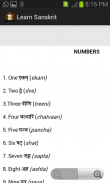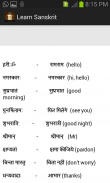









Learn Sanskrit

توضیحات Learn Sanskrit
Sanskrit is an ancient and classical language of India in which ever first book of the world Rigveda was compiled. The Vedas are dated by different scholars from 6500 B.C. to 1500 B.C. Sanskrit language must have evolved to its expressive capability prior to that. It is presumed that the language used in Vedas was prevalent in the form of different dialects. It was to some extent different from the present Sanskrit. It is termed as Vedic Sanskrit. Each Veda had its book of grammar known as Pratishakhya. The Pratishakhyas explained the forms of the words and other grammatical points. Later, so many schools of grammar developed. During this period a vast literature -Vedas, Brahmana-Granthas, Aranyakas, Upanishads and Vedangas had come to existence which could be termed as Vedic Literature being written in Vedic Sanskrit.
Panini (500 B.C.) was a great landmark in the development of Sanskrit language. He, concising about ten grammar schools prevalent during his time, wrote the master book of grammar named Ashtadhyayi which served as beacon for the later period. Literary Sanskrit and spoken Sanskrit both followed Panini’s system of language. Today the correctness of Sanskrit language is tested upon the touchstone of Panini’s Ashtadhyayee.
Sanskrit is said to belong to Indo – Aryan or Indo Germanic family of languages which includes Greek, Latin and other alike languages. William Jones, who was already familiar with Greek and Latin, when came in contact with Sanskrit, remarked that Sanskrit is more perfect than Greek, more copious than Latin and more refined than either. He said – “Sanskrit is a wonderful language”. It is noteworthy that though ancient and classical, Sanskrit is still used as medium of expression by scholars throughout India and somewhere in other parts of the world e.g. America, and Germany. Sanskrit is included in the list of modern Indian Languages in the eighth schedule of the constitution of India.
زبان سانسکریت زبانی باستانی و کلاسیک هند که در آن کتاب تا کنون اول جهان ریگودا وارد شده است. وداها توسط محققان مختلف از 6500 سال قبل از میلاد مورخ تا 1500 قبل از میلاد مسیح زبان سانسکریت باید به قابلیت بیانی آن قبل از آن تکامل یافته است. این فرض که زبان مورد استفاده در وداها در قالب لهجه های مختلف رایج بود. این تا حدی متفاوت از زبان سانسکریت حاضر بود. آن را به عنوان سانسکریت ودایی نامیده می شود. هر ودا کتاب خود از دستور زبان شناخته شده به عنوان Pratishakhya بود. Pratishakhyas اشکال از کلمات و دیگر نقاط دستوری توضیح داد. پس از آن، بسیاری از مدارس دستور زبان توسعه یافته است. در طی این مدت ادبیات گسترده -Vedas، براهمنهها-Granthas، Aranyakas، اوپانیشادها و Vedangas به وجود آمده بود که می تواند به عنوان ادبیات ودایی نامیده شدن در سانسکریت ودایی نوشته شده است.
پانینی (500 سال قبل از میلاد) یکی از نشانه های بزرگ در توسعه زبان سانسکریت بود. او، concising حدود ده مدارس دستور زبان در طول زمان خود شایع، نوشت کتاب استاد از دستور زبان به نام Ashtadhyayi که به عنوان چراغ دریایی برای دوره بعد خدمت کرده است. ادبی زبان سانسکریت و گفتاری زبان سانسکریت هر دو به دنبال سیستم پانینی از زبان. امروز صحت زبان سانسکریت است بر معیار و محک Ashtadhyayee پانینی را آزمایش کردند.
زبان سانسکریت است گفت: به متعلق به هند - خانواده آریایی یا هند و ژرمنی زبان که شامل یونانی، لاتین و سایر زبان به طور یکسان. ویلیام جونز، که در حال حاضر با یونانی و لاتین آشنا بود، زمانی که در تماس با سانسکریت آمد، اظهار داشت که زبان سانسکریت کامل تر از یونانی، فراوان تر از لاتین و تصفیه شده بیشتر از هر دو است. او گفت: - "سانسکریت زبان فوق العاده است". قابل توجه است که هر چند باستانی و کلاسیک، سانسکریت است که هنوز هم به عنوان متوسط بیان شده توسط محققان در سراسر هند در جایی در سایر نقاط به عنوان مثال جهان استفاده می شود و امریکا و آلمان. زبان سانسکریت است در لیست مدرن زبان های هندی در برنامه هشتم قانون اساسی هند گنجانده شده است.


























